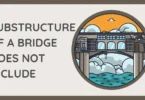Bridge engineering is one of the most important parts of civil engineering, as it focuses on designing and building safe pathways over rivers, valleys, and roads. If you are a student or learner searching for clear and simple bridge engineering notes, then this guide will help you.
Here, you will understand the history, types, materials, and step by step process of how bridges are made. Written in easy English, these notes are useful for beginners, students, and anyone who wants to know how bridges connect people and places.
History and Evolution of Bridges
Bridges are not a modern invention. People have been building them for thousands of years. Let’s take a short look at their history:
- Early wooden bridges: The first bridges were simple logs placed across streams.
- Stone bridges: Ancient civilizations like the Romans built stone arch bridges that are still standing today.
- Medieval bridges: Strong stone and brick bridges were made in Europe during the Middle Ages.
- Modern bridges: With the invention of steel and concrete, engineers built bigger and stronger bridges.
- Current era: Today, bridges use advanced materials like composite steel, high-strength concrete, and even smart sensors.
This shows that bridge engineering has evolved with time, becoming safer and more efficient.
Basic Components of a Bridge
To understand bridge engineering properly, you must first know the basic parts of a bridge:
- Substructure: The foundation, piers, and abutments that hold the bridge.
- Superstructure: The part you see above ground, including the deck, girders, and arches.
- Bearings: Devices that allow controlled movement due to temperature and load changes.
- Expansion joints: Gaps that prevent cracks by allowing the bridge to expand or shrink.
- Parapets and railings: Safety barriers for people and vehicles.
These components work together to make a bridge stable and safe.
Types of Bridges
There are many kinds of bridges, each designed for different needs. The main types are:
- Beam Bridge: Simple and straight, supported by piers.
- Arch Bridge: Curved design that carries heavy loads.
- Suspension Bridge: Uses cables to support the deck (e.g., Golden Gate Bridge).
- Cable-Stayed Bridge: Modern design with cables attached directly to towers.
- Truss Bridge: Built using triangular steel or wooden structures.
- Movable Bridge: Can be lifted or turned to allow ships to pass.
Each type has its own strengths and is chosen depending on location and purpose.
Materials Used in Bridge Construction
The strength of a bridge depends heavily on the material used. Common materials include:
- Stone and wood: Used in ancient times.
- Steel: Strong and flexible, used in modern suspension and truss bridges.
- Concrete: Durable and cost-effective, widely used today.
- Composite Materials: Lightweight and high strength, used in advanced bridges.
- Smart Materials: New materials that can repair small cracks by themselves.
Important Principles of Bridge Design
Bridge design is not just about looks. Engineers follow scientific principles:
- Load distribution: Handling dead loads (self-weight), live loads (vehicles, people), wind, and earthquakes.
- Stability: The bridge should not overturn or collapse.
- Safety factor: Extra strength is added to handle unexpected loads.
- Durability: Bridges should last for decades with minimal repair.
Step by Step Bridge Construction Process
Building a bridge is a complex process. Here’s how it happens step by step:
- Planning and Survey: Engineers study the site, soil, and traffic needs.
- Designing: Computer software is used to make safe and economical designs.
- Foundation Work: Deep foundations are made to hold the bridge.
- Substructure Construction: Piers and abutments are built.
- Superstructure Construction: Decks, beams, cables, or arches are installed.
- Finishing Works: Pavement, safety barriers, lighting, and markings are added.
- Testing and Opening: The bridge is checked for strength and safety before opening to the public.
Modern Technologies in Bridge Engineering
Technology has made bridges stronger and smarter:
- Computer-aided design (CAD): Helps engineers make precise designs.
- Prefabricated bridges: Built in parts and assembled quickly on-site.
- Smart sensors: Installed to detect cracks, vibrations, and overload.
- Eco-friendly designs: Reduce environmental damage.
- Drones: Used for bridge inspections.
Famous Bridges Around the World
Some bridges are known worldwide for their design and beauty:
- Golden Gate Bridge (USA) – Famous suspension bridge.
- Tower Bridge (UK) – Historical movable bridge.
- Millau Viaduct (France) – One of the tallest bridges in the world.
- Akashi Kaikyō Bridge (Japan) – The longest suspension bridge.
These bridges are not only engineering marvels but also tourist attractions.
Challenges in Bridge Engineering
Engineers face many challenges while building and maintaining bridges:
- Natural disasters like floods and earthquakes.
- Heavy traffic and overloading.
- Corrosion and rust in steel parts.
- High cost of construction and maintenance.
- Environmental restrictions.
Maintenance and Safety of Bridges
Bridges must be checked regularly for safety. Important maintenance steps include:
- Inspection: Regular visual checks and advanced testing.
- Repairs: Fixing cracks, replacing worn parts, and repainting steel.
- Strengthening: Adding extra supports if traffic increases.
- Safety checks: Ensuring bridges can handle emergency situations.
Future of Bridge Engineering
The future looks exciting with new ideas:
- Smart bridges with AI and IoT sensors.
- Self healing concrete that repairs itself.
- Lightweight composite materials for stronger designs.
- Eco-friendly bridges that protect the environment.
- Robotics for automatic maintenance.
Common FAQs About Bridge Engineering Notes
Some faqs of Bridge Engineering Notes:
What are the main parts of a bridge?
The main parts are substructure, superstructure, bearings, and safety features.
Which material is best for building bridges?
Steel and reinforced concrete are the most commonly used materials.
What is the strongest type of bridge?
Suspension and cable-stayed bridges are considered the strongest.
How long can a bridge last?
A well-maintained bridge can last 50–100 years or more.
Who designs bridges?
Civil engineers and structural engineers design bridges.
Conclusion
Bridge engineering is an essential field of civil engineering. It combines science, technology, and creativity to build safe structures that connect people and places. From ancient stone bridges to modern smart bridges, this field has always evolved.
By reading these bridge engineering notes, you have learned about the history, types, components, materials, construction process, challenges, and future of bridges. Understanding bridges is not only useful for engineering students but also for anyone who wishes to appreciate how these amazing structures make our lives easier.






